Research Areas
Summaries of the Ober Group's research interests are listed below, along with the names of the group members working on each project. Please click on the titles or the expand/shrink links of the individual projects to read the project descriptions.
Transient Polymer Photoresists
▶ Huseyin Cem Kiliclar, Madan Rajendra Biradar
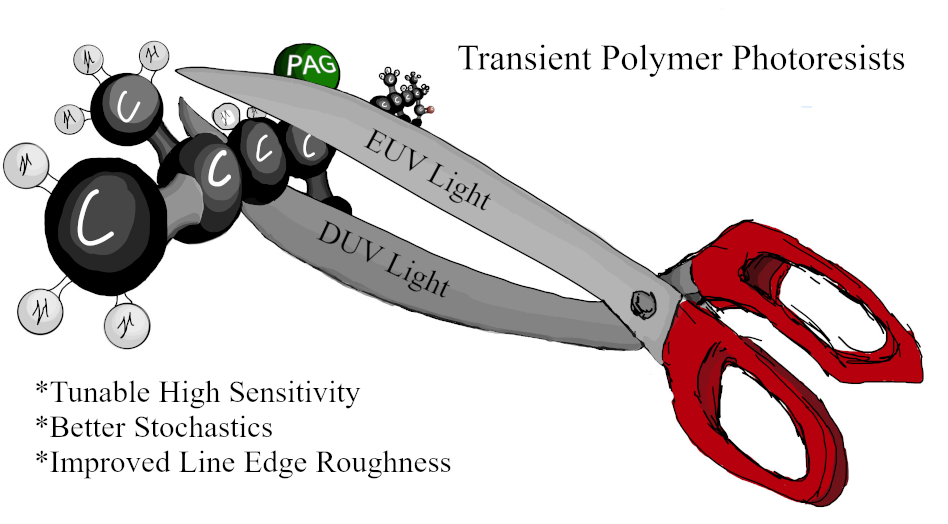
Illustration of Transient Polymer Photoresists.
[▼ Expand/shrink description ]
As we live in an era that demands an increasing computational power each day, the
semiconductor industry pushes the limits of photoresists to develop better chips. However, the
current state of photoresists often falls short of meeting industry goals, particularly in
addressing the persistent challenge of stochastics a concern that has yet to be effectively
tackled by existing resist systems. In order to satisfy the increasingly strict pattern fidelity and
resolution requirements of the industry, transient polymers functionalized with photo acid
generators are being developed. Functionalities that can be triggered by electron beams or
light with specific wavelengths including deep ultra violet (DUV) or extreme ultra-violet
(EUV) can be utilized in the modification processes. Therefore, a novel approach to develop
low-exposure-dose, sensitive photoresists, free from the limitations of conventional systems is
important. Our proposed methodologies involve incorporating photoactive compounds while
controlling molecular weight and distribution into the field of chain scissionable polymers.
Chain scissionable polymers are typically characterized by a low ceiling temperature (Ic) and
can undergo controlled degradation in response to external stimuli, such as light, heat, pH, or
oxidation conditions. These polymers feature weak chemical bonds that can be cleaved by
external triggers, initiating a swift degradation process. Owing to their intriguing properties,
these polymers have found applications in various fields, including lithography, drug delivery,
self-healing materials, and transient electronics. Through some comprehensive studies, we
aim to identify the optimal strategy based on factors such as lithographic performance, shelf
stability, the impact on stochastics, and other relevant variables. Recently published research
articles on the topic involved polyphthalaldehydes as the degradable polymer main chain and
non-ionic photoacid generators (PAGs) as the trigger for degradation.
[▲ Shrink description ]
Selected Publications
- Jingyuan Deng, Sean Bailey, Shaoyi Jiang, and Christopher K. Ober, A Modular Synthesis of Phthalaldehyde Derivatives Enabling Access to Photoacid Generator Bound Self-Immolative Polymer Resists with Next Generation Photolithographic Properties, JACS, https://doi.org/10.1021/jacs.2c08202.
- Jingyuan Deng, Sean Bailey, Ruiwen Ai, Anthony Delmonico, Gregory Denbeaux, Shaoyi Jiang & Christopher K. Ober. (2022). Synthesis of End-Cap Enabled Self-Immolative Photoresists For Extreme Ultraviolet Lithography. ACS Macro Letters. 11(9), 1049-1054, doi:10.1021/acsmacrolett.2c00395
- Chengjian Shi, Amanda Leonardi, Peter Ohlendorf, Yiren Zhang, Alex Ruyack, Amit Lal and Christopher K. Ober, "UV-triggered Transient Electrospun Poly(Propylene Carbonate)/Poly(Phthalaldehyde) Polymer Blend Fiber Mats", ACS Applied Materials & Interfaces, (2018), 10(34), 28928-28935.
Sequence-Defined Polypeptoid as EUV Resist
▶Chenyun Yuan
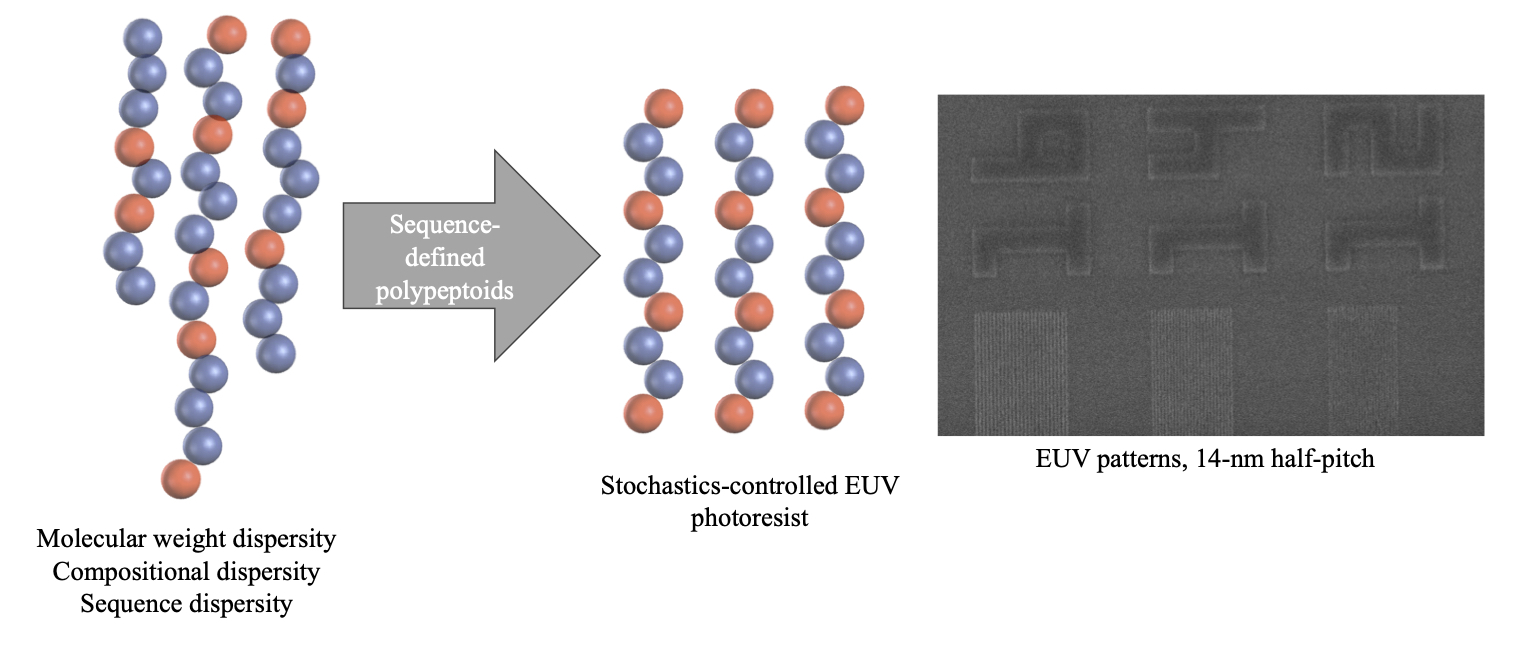
Sequence-defined polypeptoids as next-generation EUV photoresists with enhanced stochastic control.
[▼ Expand/shrink description ]
This project centers around the development of advanced photoresists essential for semiconductor production, propelled by the increasing demand for finer patterning resolution in line with Moore's Law. The primary motivation stems from the challenges posed by the shift to shorter wavelength lithography, which has highlighted issues with the speed and stochastic behavior of current photoresists. Addressing these concerns, the project aims to refine the molecular properties of photoresists using sequence-defined polypeptoids, which can be synthesized with precise molecular weight, composition, and sequence through the solid-phase submonomer synthesis method. This approach also surpasses the capabilities of traditional polymerization techniques, allowing for the integration of metal atoms with high EUV absorption to improve the photoresist sensitivity.
The scope of the project entails creating polypeptoids with lengths of 5-30 units, incorporating functional groups to optimize lithographic performance. These polypeptoids are synthesized on resin beads, followed by cleavage, purification, and confirmation of their structure and purity. Subsequent steps include spin-coating the polypeptoids onto silicon wafers and exposing them to lithographic processes like deep UV, e-beam, and extreme UV. The research explores various chemical structures to adjust lithographic performance and other key properties such as glass transition temperature and adhesion, utilizing various functionalities for solubility control and metal-binding for enhanced lithography outcomes. The project's approach to molecular engineering aims to pioneer new lithography techniques, significantly impacting the production capabilities and effectiveness of photoresists for future semiconductor manufacturing.
[▲ Shrink description ]
Selected Publications
- Florian Kaefer, Chenyun Yuan, Cameron Adams, Rachel Segalman and Christopher K. Ober, Photoresist Design to Address Stochastics Issues in EUV Resists, J. Photopolym. Sci. Tech., 36(1), 61-66 (2023).
Clickable non-ionic Photoacid Generators (PAGs)
▶Chaoqiuyu (Rachel) Wang, Danya Liu
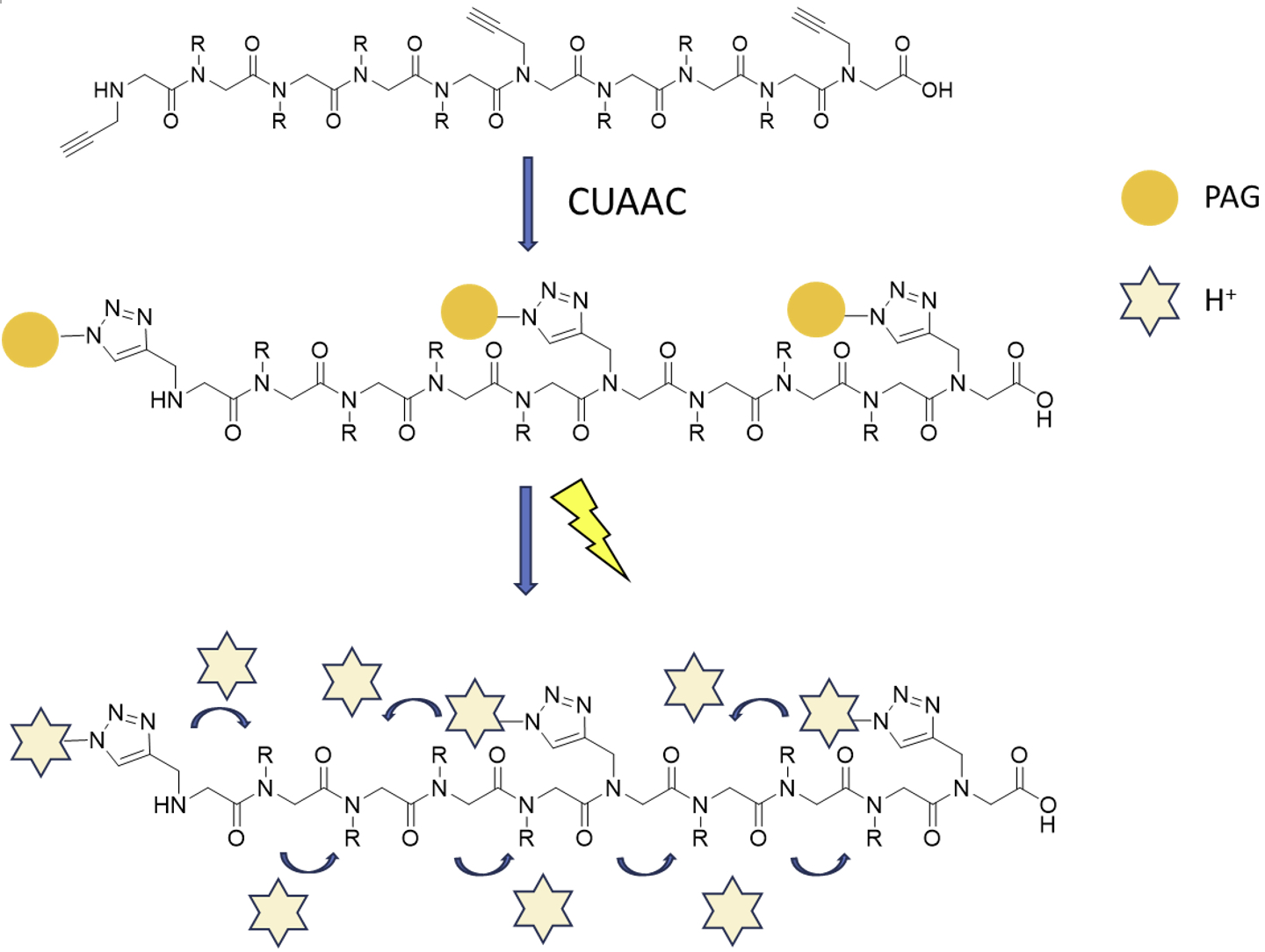
Synthetic route of Clickable non-ionic PAGs.
[▼ Expand/shrink description ]
Polymer brushes have recently attracted considerable interest for generating molecularly defined surfaces for applications in nanotechnology, molecular biology, and biomedical sciences. Two main advantages of using polymer brush systems are the ability to mitigate non-specific adsorption and the creation of tailor-made surfaces to control the immobilization of bioanalytes through specific receptor recognition interactions. The use of polymer brushes allows the formation of uniform surfaces with controlled chemical architecture that exhibit good chemical and thermal stability.
One area of polymer brushes being explored is that of patterned brushes, which can be used to create surfaces with tailored surface properties. Various patterning methods have been used to fabricate patterned polymer brushes, the most conventional methods involve patterning of surface immobilized initiator followed by surface initiated polymerization. To simplify the process, our group patterns features in the nanometer regime by direct e-beam lithography. Currently, we are investigating the responsive nature in different solvents of binary brush systems at selected feature sizes. Polymer brushes are chosen by their ability to swell in a good solvent and cover the neighboring brush which is in a collapsed state. Other patterning projects include exploring the morphology of e-beam patterned block copolymer brushes. Our results show that pattern size and solvent treatment influence the morphology of phase separated block copolymer brushes.
[▲ Shrink description ]
Selected Publications
- Florian Kaefer, Chaoqiuyu Wang, Yuming Huang, Francesca Bard, Rachel Segalman, Christopher K. Ober, Polypeptoids, exploring the power of sequence control in a photoresist for extreme-ultraviolet lithography, Advanced Materials Technologies; 10.1002/ADMT202301104
Polymer Brushes
▶Gozde Aktas Eken, Yuming (Robin) Huang, Yixin (Janet) Guo
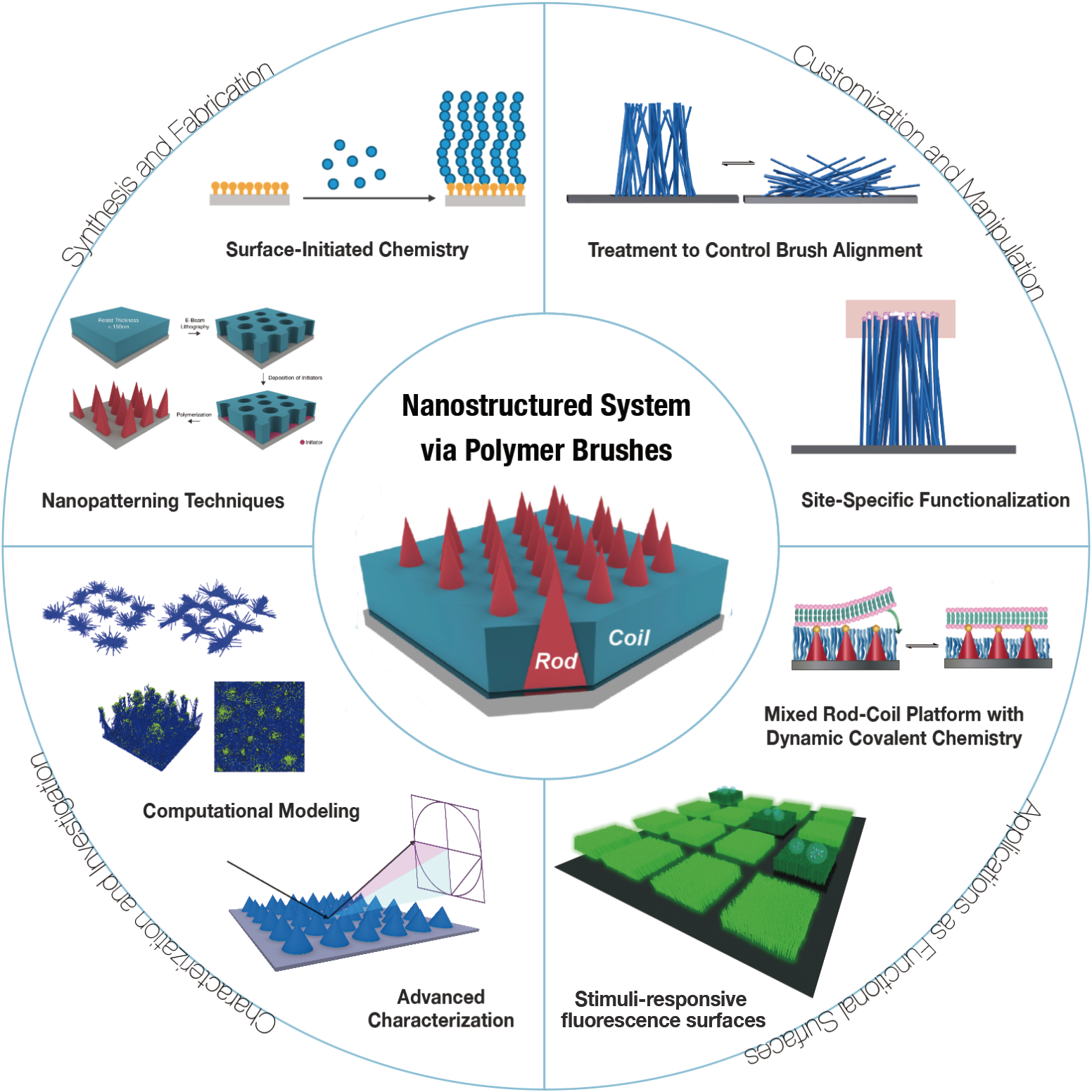
Overview of nanostructured system comprised of mixed rod-coil polymer brushes.
[▼ Expand/shrink description ]
Polymer brushes have recently attracted considerable interest for generating molecularly defined surfaces for applications in nanotechnology, molecular biology, and biomedical sciences. Two main advantages of using polymer brush systems are the ability to mitigate non-specific adsorption and the creation of tailor-made surfaces to control the immobilization of bioanalytes through specific receptor recognition interactions. The use of polymer brushes allows the formation of uniform surfaces with controlled chemical architecture that exhibit good chemical and thermal stability.
One area of polymer brushes being explored is that of patterned brushes, which can be used to create surfaces with tailored surface properties. Various patterning methods have been used to fabricate patterned polymer brushes, the most conventional methods involve patterning of surface immobilized initiator followed by surface initiated polymerization. To simplify the process, our group patterns features in the nanometer regime by direct e-beam lithography. Currently, we are investigating the responsive nature in different solvents of binary brush systems at selected feature sizes. Polymer brushes are chosen by their ability to swell in a good solvent and cover the neighboring brush which is in a collapsed state. Other patterning projects include exploring the morphology of e-beam patterned block copolymer brushes. Our results show that pattern size and solvent treatment influence the morphology of phase separated block copolymer brushes.
[▲ Shrink description ]
Selected Publications
- Gozde Aktas Eken, Yuming Huang, Oswald Prucker, Jurgen Ruhe, Christopher Ober, Advancing Glucose Sensing Through Auto-Fluorescent Polymer Brushes: From Surface Design to Nano-Arrays, Small, accepted. 10.1002/smll.202309040
- Gozde Aktas Eken, Yuming Huang, Yixin Guo, Christopher K. Ober, Visualization of pH response through auto-fluorescent poly(styrene-alt-N-maleimide) polyelectrolyte brushes, ACS Applied Polymer Materials, 2023, 5, 2, 1613-1623.
- Huang, Yuming, Tran, Hai and Ober, Christopher K. High-Resolution Nanopatterning of Free-standing, Self-supported Helical Polypeptide Rod Brushes via Electron Beam Lithography. Acs Macro Letters, 2021, 10:755-759. doi:10.1021/acsmacrolett.1c00187
Anti-biofouling Surface-Active Block Copolymers
▶ Zhenglin Zhang, Emma Hester, Swapnil Madan Vaidya
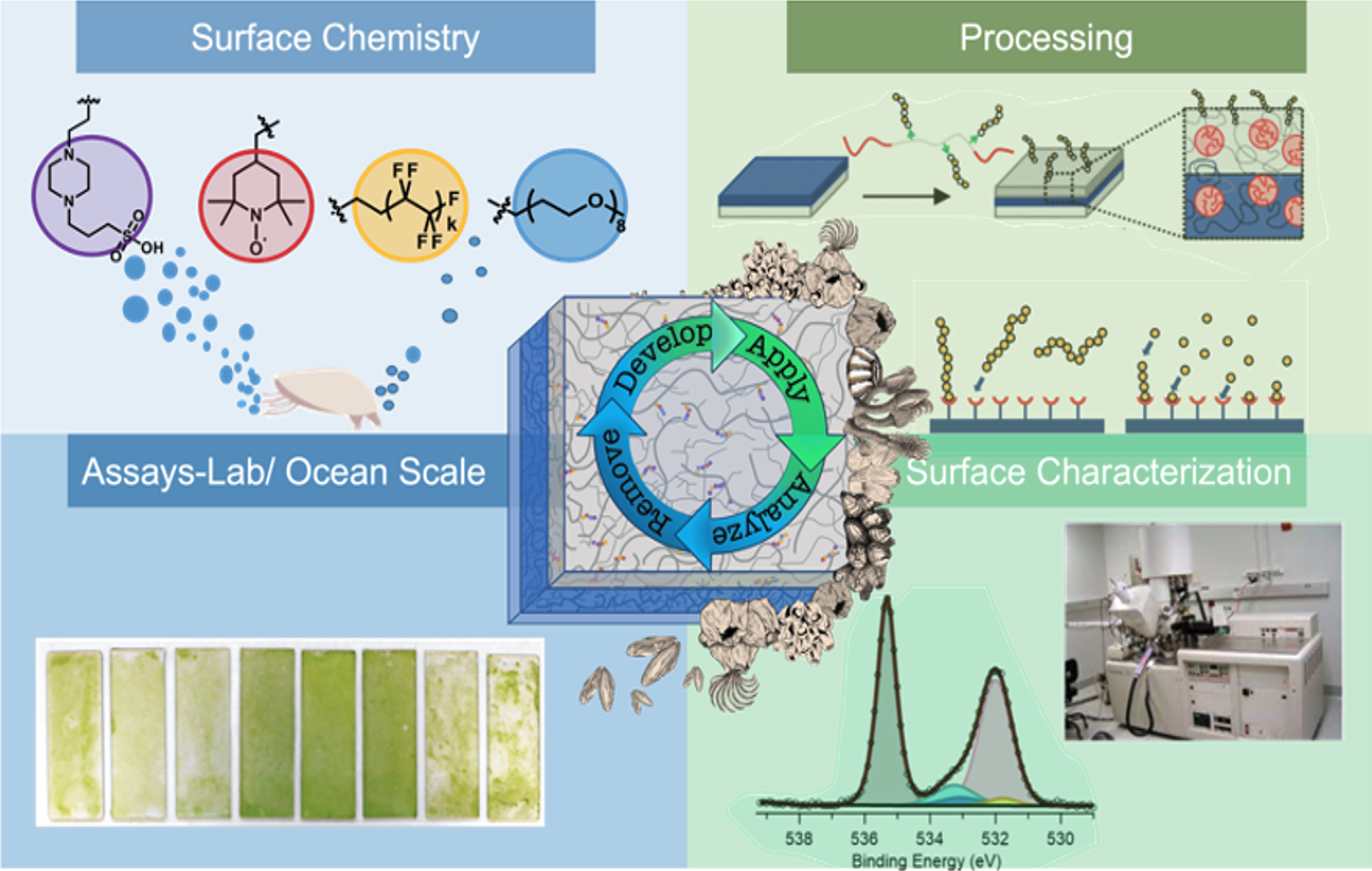
[▼ Expand/shrink description ]
Fouling of marine surfaces is a historically difficult and costly economic problem; build-up of micro-organisms, algae, and calcareous species on the surface of ship hulls results in decreased fuel efficiency and maneuverability, increased maintenance frequency and costs, and increased spread of invasive species. Many commercially available antifouling paints incorporate harmful biocides that have detrimental side effects on the marine environment, so there is a growing need for benign alternatives.
There are currently over 4000 known marine fouling species that use a diverse set of chemical and physical mechanisms to adhere to marine surfaces, and to combat this requires complex, multifunctional materials. Our research focuses on the development of a biocide-free antifouling and fouling release coating (to prevent settlement and to enhance removal by shear forces, respectively) that is universally effective. Using a system of modifiable surface-active block copolymers (SABC), we have systematically screened and identified a variety of functionalities for their performance against marine organisms. Now, in collaboration with the Segalman group in Chemical Engineering at the University of California - Santa Barbara, we are using sequence-controlled chemistry to include a variety of hydrophobic, hydrophilic, and active chemistries that alter the SABC surface properties. This gives us the ability to precisely tune the surface characteristics of our coatings and to optimize their performance against a wide variety of marine species.
[▲ Shrink description ]
Selected Publications
- Riddhiman Mehdi, Alicia Cintora, Amanda Leonardi, Elisa Martinelli, John A. Finlay, Anthony S. Clare, Christopher K. Ober, Giancarlo Galli, Nitroxide-Containing Amphiphilic Random Terpolymers for Marine Antifouling and Fouling-Release Coatings, ACS Appl. Mat. Inter., 2023, 15, 8, 11150-11162.
- Amanda Leonardi, Riddhiman Mehdi, Aria C. Zhang, Nilay Duzen, John A. Finlay, Jessica L. Clarke, Anthony S. Clare, Christopher K. Ober. Investigation of N-Substituted Morpholine Structures in an Amphiphilic PDMS-Based Antifouling and Fouling Release Coating, Biomacromolecules, doi: 10.1021/acs.biomac.1c01474.
- Leonardi, Amanda, Aria C. Zhang, Nilay Duzen, Nick Aldred, John A. Finlay, Jessica L. Clarke, Anthony S. Clare, Rachel A. Segalman, and Christopher K. Ober. "Amphiphilic Nitroxide-Bearing Siloxane-Based Block Copolymer Coatings for Enhanced Marine Fouling Release." ACS Applied Materials & Interfaces 13.24 (2021): 28790-8801. doi:10.1021/acsami.1c05266
- Amanda K. Leonardi and Christopher K. Ober, "Polymer-Based Marine Antifouling and Fouling Release Surfaces: Strategies for Synthesis and Modification", Annual Review of Chemical and Biomolecular Engineering, 2019, 10, 241-264.
Mixed Ionic Electronic Conductors
▶ Chaoqiuyu (Rachel) Wang
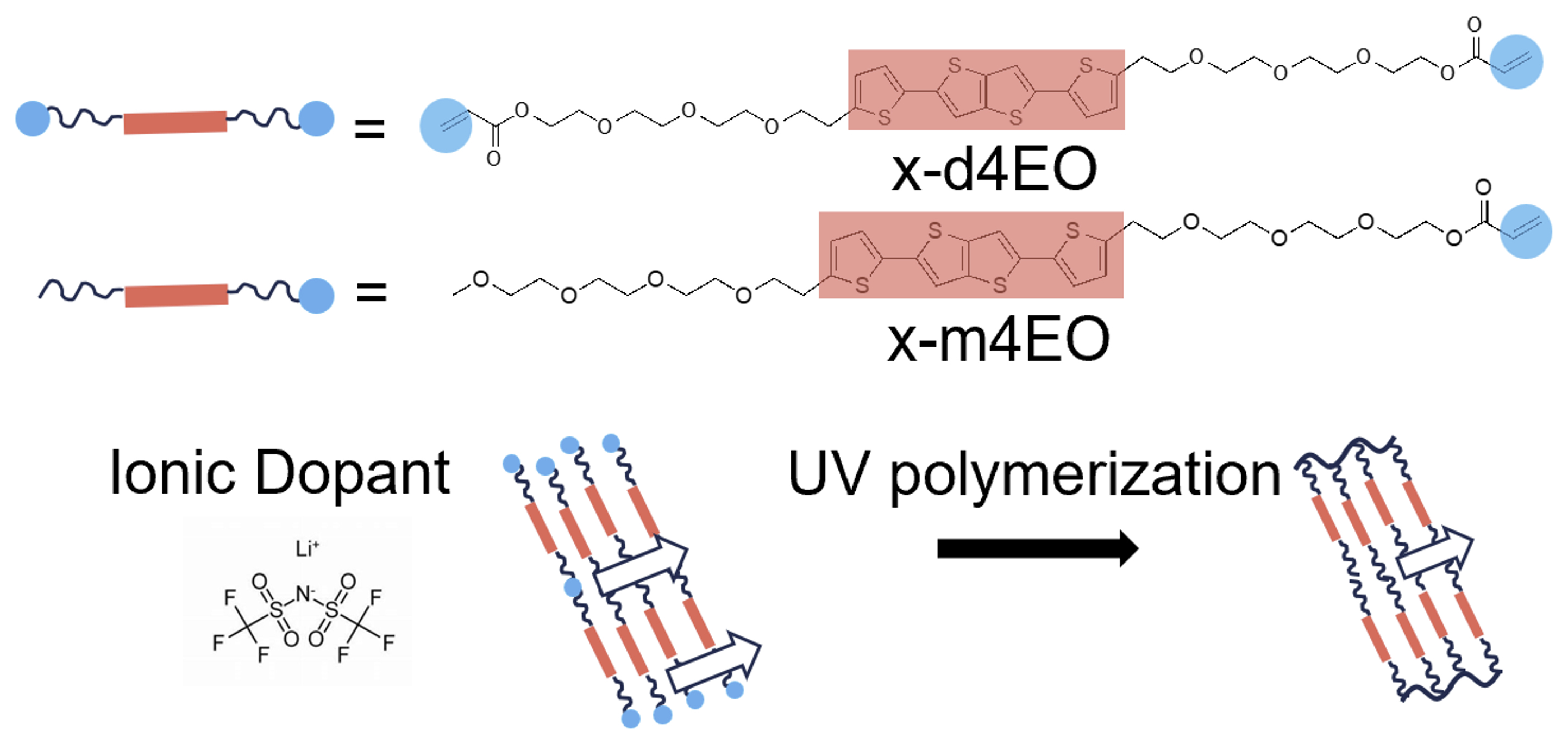
Liquid crytals with immiscible ionic conducting building blocks and electronic conducting building blocks can self-assemble into specific phases generating co-continuous domains for ion and electronic carrier transport, respectively.
[▼ Expand/shrink description ]
Organic mixed ion/electron conductors has recently been attractive due to the needs of such material in advanced applications such as bioelectronics, energy storage and robotic actuators. However, the mechanism of structure-transport properties of such a complicated system remains poorly understood. This program between Cornell, Chicago and U Washington is a joint experimental and computational study of the synthesis, self-assembly and electronic / ionic conduction characteristics of a series of new conjugated liquid crystals (LCs).
In our previous study, a liquid crystal consisting of terminal tetra-ethylene oxide groups on both ends of a quaterthiophene core exhibits ordered smectic phase, and the dual conduction property was confirmed via electrochemical analysis. In our recent study, the quarter thiophene core is replaced with a fused thieno[3,2-b]thiophene for enlarging the molecule’s planarity and improving the self-assembly efficiency. Upon the structural engineering, the measured ionic conductivity achieved a 10-time increase compared with the prior design. The ion transport mechanism and the source for property improvement was further analyzed through molecular dynamic simulation studies.
Currently we are focusing on upgrading the material from a theoretical model toward a real material for device applications. The strategy is to chemically modify the LC into polymerizable monomers. By applying the solid-state photo-initiated polymerization, the self-assembled structure spontaneously formed due to the intrinsic character of LC is firmly locked. Two types of monomers, mono- and di-functionalized molecules were developed for polymerization and crosslinker, respectively. The factors such as blending ratio of the two monomers, doping concentrations, and degree of salt dissociation on ionic conductivity and mechanical properties are investigated.
[▲ Shrink description ]
Selected Publications
- Zhongyang Wang, Chaoqiuyu Wang, Yangyang Sun, Kai Wang, Joseph Strzalka, Fernando A. Escobedo, Christopher K. Ober, Shrayesh N. Patel and Paul F. Nealey, Ion Transport in 2D Nanostructured pi-Conjugated Oligothiophene-Based Liquid Crystals, ACS Nano, 2022, 16(12), 20714-20729; doi.org/10.1021/acsnano.2c07789
- Ban Xuan Dong, Ziwei Liu, Jonathan W. Onorato, Tengzhou Ma, Joseph Strzalka, Peter Bennington, Christine K. Luscombe, Christopher K. Ober, Paul F. Nealey and Shrayesh N. Patel. (2021). Ionic Dopant-Induced Ordering Enhances the Thermoelectric Properties of a Polythiophene-Based Block Copolymer. Advanced Functional Materials. doi:10.1002/adfm.202106991
- Misra, Mayank, Liu, Ziwei, Dong, Ban Xuan, Patel, Shrayesh N., Nealey, Paul F., Ober, Christopher K., and Escobedo, Fernando A. (2020). Thermal Stability of pi-Conjugated n-Ethylene-Glycol-Terminated Quaterthiophene Oligomers: A Computational and Experimental Study. Acs Macro Letters, 9(3), 295-300. doi:10.1021/acsmacrolett.9b00935
- Liu, Ziwei; Dong, Ban Xuan; Misra, Mayank; Sun, Yangyang; Strzalka, Joseph; Patel, Shrayesh N.; Escobedo, Fernando A.; Nealey, Paul F.; Ober, Christopher K., "Self-Assembly Behavior of an Oligothiophene-Based Conjugated Liquid Crystal and Its Implication for Ionic Conductivity Characteristics", Advanced Functional Materials 29(2), 1805220 (2019).
Polymer-Grafted Nanoparticles
▶ Yu Shao, Siddhantt Sunil Bhamare, Ishwari Chaitanya Joshi

Overview of Polymer-Grafted Nanoparticles.
[▼ Expand/shrink description ]
Polymer-grafted nanoparticles (PGNs) were synthesized by mini-emulsion polymerization using Activator Regenerated Electron Transfer (ARGET)/Atom Transfer Radical Polymerization (ATRP). Initially, the surface of mono-disperse silica nanoparticles (25 nm) were modified by an ATRP initiator and different polymers such as Poly(methyl methacrylate), Polystyrene and Poly(N-isopropylacrylamide) were grafted on the particle surface. Thereby, phase transfer agents, such as tetrabutylammonium bromide (TBAB), assists the transfer of monomer and the ATRP catalyst-complex to the particle surface for a locally controlled polymerization. Furthermore, the brush canopy size, graft density and molar mass of the grafted polymer chains can be controlled by changing the monomer feeding rate and the monomer concentration. The resulting well-defined PGNs are an important building block for the creation of functional superlattices by changing the entanglement and the interactions between the PGNs. This work opens the potential for photonic devices and sensors.
Through the combination of in-situ synchrotron X-ray scattering and advanced laser spike annealing technic, we are about to fabricate a serial of inorganic-inorganic core-shell nanoparticles based on unique polymer precursor and unfold the structure-property relationship towards the cutting edge magnetic and photo responsive materials.
[▲ Shrink description ]
Selected Publications
- Alicia Cintora, Florian Kafer, Chenyun Yuan and Christopher K. Ober. (2021). Effect of monomer hydrophilicity on ARGET–ATRP kinetics in aqueous mini-emulsion polymerization. doi:10.1002/pol.20210658
- Wu, Dung-Yi, Kafer, Florian, Diaco, Nicholas, and Ober, Christopher K. (2020). Silica-PMMA hairy nanoparticles prepared via phase transfer-assisted aqueous miniemulsion atom transfer radical polymerization. Journal of Polymer Science, 58(17), 2310-2316. doi:10.1002/pol.20200382






